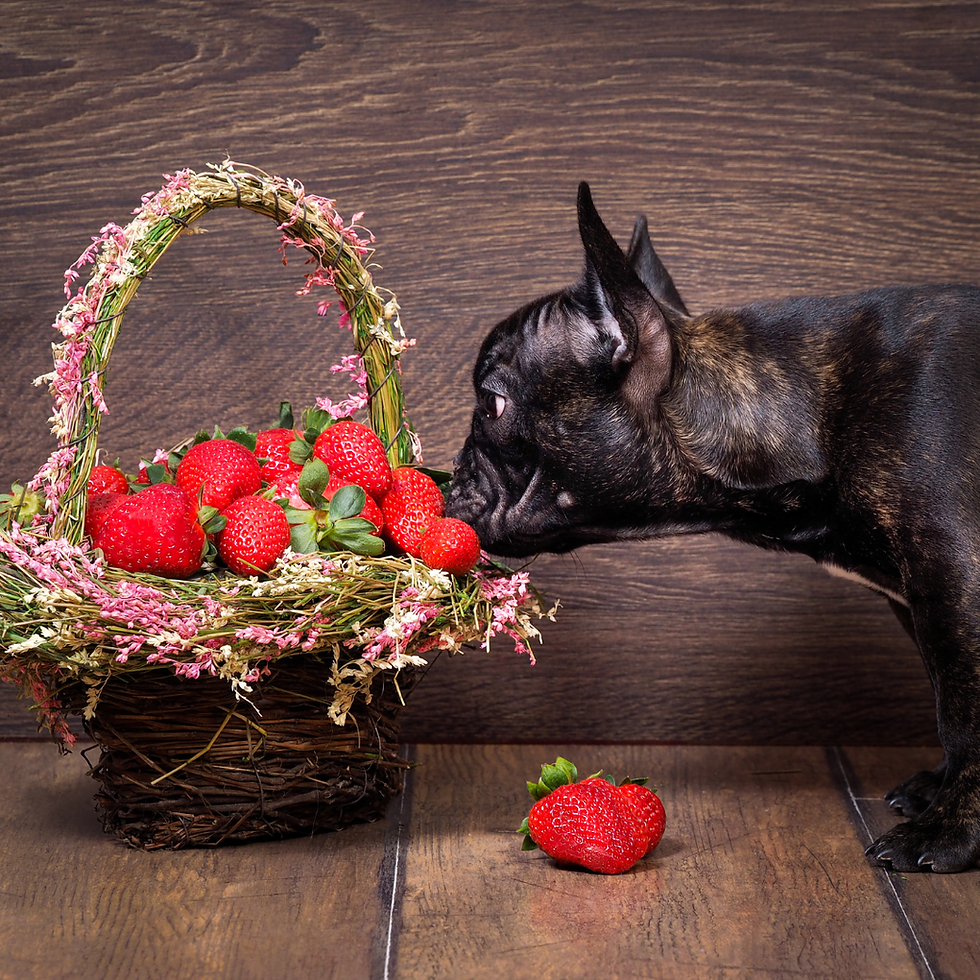Popular Summer Produce- Good for your Pets?
- Mobile Veterinary Practice WI

- Jul 30, 2021
- 4 min read

Are Strawberries and Carrots good for your Dog? Find out Below!
Carrots are a versatile vegetable. They can stand alone as a snack, pair with a roast and potatoes or add flavor to stock or soup.
The vitamins and minerals this vegetable contains make them great for humans, but can dogs eat carrots? Purina experts say yes, dogs can eat carrots. Not only can they eat them, but most dogs also enjoy them. Below our experts explain why carrots are good for dogs, how to serve them and more.
Can Dogs Have Carrots?
Like many other fruits and vegetables, dogs can have carrots. In fact, every part of this vegetable, from the carrot itself to the leafy green tops are safe for dogs to eat. They’re a good, natural treat, and most dogs like the flavor, too.
Are Carrots Good for Dogs?
Carrots contain essential vitamins and minerals like beta carotene (which the body converts to vitamin A), vitamin K, potassium and more. Although these nutrients are good for humans, can dogs reap the same benefits?
Because you aren’t relying on carrots alone to give your dog the nutrients he needs, he’s unlikely to see major benefits from small amounts of this vegetable. That said, it’s still a healthy and tasty treat for your pooch.
When Are Carrots Bad for Dogs?
In moderation, carrots are a healthy, low-calorie treat. Like other fruits and vegetables, though, they’re high in natural sugar. This is why dogs (and humans) find them so tasty. Too much sugar, even the natural kind, can cause weight gain, which can lead to other health problems.
“The same rules apply to serving carrots as they do with any other treat,” says Purina Senior Nutritionist Jan Dempsey. Meaning carrots should make up no more than 10% of your dog’s daily calories.
Although dogs aren’t usually at risk for cavities, too many high-sugar treats could lead to dental decay. Unlike more abrasive dog food and treats, which clean the teeth, carrots won’t clean your dog’s teeth as he eats.
How to Serve Carrots for Dogs
Before giving your dog a new food, check with us to get the ideal serving size based on their weight and breed. You can slice them into rounds or cut them into sticks or smaller or larger pieces, depending on your dog’s size.
Your dog may enjoy the crunch and flavor of raw carrots, but if he doesn’t like them raw, try giving him cooked carrots. If you’re worried about altering the carrots’ nutritional value by cooking them, don’t.
“Steaming or cooking minimally in the microwave shouldn’t cause a major change in vitamins and minerals in carrots,” says Dempsey. “But don’t boil the vegetable, since boiling tends to leach out nutrients. Just know however you fix them, carrots are not bad for dogs.”
Are strawberries good for dogs to eat?
Strawberries are good for dogs. But feed strawberries to your dog like you would any other snack. Keep the portion size small. “Treats you feed your dog should make up no more than 10% of his total calories for the day,” Purina Senior Nutritionist, Jan Dempsey says. Use this as a guide so the strawberries you feed your dog won’t cause him to gain extra pounds.
We love to eat strawberries because they are sweet. But sweet means sugar. And a lot of sugar, even in fruit, isn’t beneficial to dogs. That’s another reason to feed strawberries in moderation.
Are strawberries good for dogs?
Strawberries have some characteristics and nutrients that may be good for your dog. Strawberries have:
High water content
Fiber
Vitamin C
A teeth-whitening enzyme
“Strawberries (and some other berries) are known to contain natural compounds that act as antioxidants in the body. Research shows they are good for humans and some other animals, but whether or not there are benefits for your dog hasn’t been tested yet,” explains Dempsey.
What is the best way to prepare strawberries for dogs?
“Wash and clean strawberries for your dog just like you would for your family,” Dempsey says. Washing helps rinse away dirt and residual chemicals.
Keep in mind that any food can be a choking hazard, even strawberries. So, after washing, trim off the stem. Is your dog a small breed dog or a puppy? Make strawberries even easier to eat. Cut them into small bits or puree them–mashing works well, too. For larger dogs, cut them in half or serve the berry whole.
How should I introduce my dog to strawberries?
“Some dogs might not know what to do with the new texture of strawberries. So you can try feeding them as frozen treats,” says Dempsey. Whatever way you serve them, start out slowly. Dempsey recommends, “Try feeding a single berry to see his reaction. If he likes them, you can try putting them on his food, but make sure he likes them first.”
Feeding the berries slowly means you’ll notice right away if they are causing a problem. Call us immediately if you notice stomach upset, digestive issues, intense scratching or an increase in thirst. Any of these can indicate strawberries aren’t right for your dog.
When strawberries are out of season, can I feed canned strawberries?
Absolutely not. “Don’t feed fruit that has been sugared or packed in syrup. This adds excess sugars and calories to fruit and defeats the purpose of feeding a ‘healthy’ treat,” Dempsey explains. Also, the canned and syrup strawberries may have additives in them—like the artificial sweetener xylitol–that can be dangerous, even deadly to your dog.
Since strawberries are safe for dogs, are other berries safe, too?
“Yes! Blueberries, raspberries, blackberries and cranberries are safe options for dogs, too. Although cranberries can be bitter and in general dogs do not like bitter taste,” Dempsey says. Not all berries are safe for your dog. Some—juniper berries or berries with pits–can be dangerous for them to eat. Always be careful and research any new food before feeding it to him.
This article was re-posted from www.purina.com Find both of them here- https://www.purina.com/articles/dog/nutrition/can-dogs-eat-strawberries and https://www.purina.com/articles/dog/nutrition/can-dogs-eat-carrots




Comments